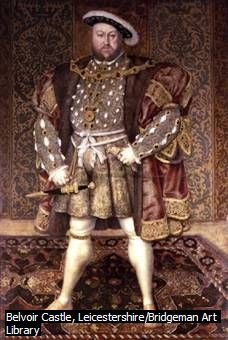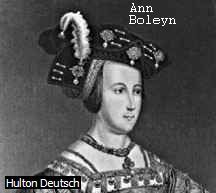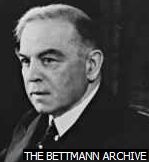.
Based on Merriam-Webster's
Collegiate® Dictionary
Use the BACK button
on your browser to return
King Henry VIII.(1491-1547)
king of England (1509-1547)
  Henry
VIII had six wives, fought numerous wars in Europe and even aspired to
become Holy Roman Emperor in order to extend his control to Europe. He
rejected the authority of the pope and the Roman Catholic Church, confiscated
church lands and promoted religious reformers to power (*).
His greatest achievement was to initiate the
Protestant Reformation in England. He ruthlessly increased the power
of royal government, using Parliament to sanction
his actions. Henry ruled through powerful ministers who, like his six wives
were never safe in their positions. He is most famous for founding the
Church of England and for having six wives, two of whom he had beheaded. Henry
VIII had six wives, fought numerous wars in Europe and even aspired to
become Holy Roman Emperor in order to extend his control to Europe. He
rejected the authority of the pope and the Roman Catholic Church, confiscated
church lands and promoted religious reformers to power (*).
His greatest achievement was to initiate the
Protestant Reformation in England. He ruthlessly increased the power
of royal government, using Parliament to sanction
his actions. Henry ruled through powerful ministers who, like his six wives
were never safe in their positions. He is most famous for founding the
Church of England and for having six wives, two of whom he had beheaded.
Henry's wives were:
Catherine of Aragón.was
married to Henry at twelve years old. The pope refused to make a decision
on Henry's proposed annulment and in 1533 Henry was married to Anne
Boleyn by the archbishop of Canterbury. In 1534 the pope finally declared
that the first marriage was valid, thus bringing about the alienation of
Henry VIII from the Roman Catholic church. Catherine did not quit the kingdom,
but was thereafter closely guarded. During this time she displayed heroic
courage and steadfastly refused to sign away her rights and those of Mary
her daughter.
Anne Boleyn.lasted
less than a month, Henry having tired of her quickly. On May 2, 1536, Anne
was imprisoned in the Tower of London on apparent charges of adultery with
her brother, three gentlemen of the privy chamber and a musician of the
court and of conspiring with these men against the king's life. She was
executed and replaced by Jane Seymour.
Jane Seymour.served
as a lady in waiting to Catherine of Aragón and later to Anne Boleyn.
Less than two weeks after the execution of Anne Boleyn, Jane privately
married the king. She died on October 24, 1537, 12 days after the birth
of her son, Edward, Henry's only male heir, later King Edward VI of England.
Her portrait was destroyed by fire in 1698.
Anne of Cleves.was
divorced by Henry six months into the marriage on July 9, 1540.
Catherine Howard.was
accused of immoral conduct both before and during her marriage. She admitted
to premarital relations and her accusers produced witnesses to testify
to her adultery. Two of her accused lovers were beheaded in December and
on February 13, 1542, she, too, was beheaded in the Tower of London.
Catherine Parr.was
sixth and last queen of Henry. After Henry's death and the accession of
Edward VI, she married the new king's uncle, Thomas Seymour, Baron Seymour
of Sudeley.
 
comprised
from Microsoft® Encarta® Encyclopedia 99. © 1993-1998 Microsoft
Corporation. All rights reserved
King,
William
Lyon Mackenzie.(10th
prime minister of Canada 1921-1926, 1926-1930, 1935-1948)
 former
civil servant, a graduate in economics and government, and member of the
Liberal Party; was the tenth prime minister of Canada. In 1914 he took
a job in the United States as director of industrial research with the
Rockefeller Foundation. He is reputed to have consulted spirits for guidance.
Seeing how he deceived Canada for his own gain and for the gain of central
Canada, we now know the type of spirits he was involved with..comprised
from Microsoft® Encarta® Encyclopedia 99. © 1993-1998 Microsoft
Corporation. All rights reserved. former
civil servant, a graduate in economics and government, and member of the
Liberal Party; was the tenth prime minister of Canada. In 1914 he took
a job in the United States as director of industrial research with the
Rockefeller Foundation. He is reputed to have consulted spirits for guidance.
Seeing how he deceived Canada for his own gain and for the gain of central
Canada, we now know the type of spirits he was involved with..comprised
from Microsoft® Encarta® Encyclopedia 99. © 1993-1998 Microsoft
Corporation. All rights reserved.
kleptocracy,
kleptocracies,
kleptocratic
a government characterized by rampant greed and
corruption
knell,
knelled,
knelling,
knells
to signal, summon, or proclaim by tolling; to
ring slowly and solemnly, especially for a funeral; toll; to give forth
a mournful or ominous sound; the sound of a bell knelling; a toll; a signal
of disaster, destruction or usually death
kowtow,
kowtowed,
kowtowing,
kowtows
to kneel and touch the forehead to the ground
in expression of deep respect, worship, or submission, as formerly done
in China; to show servile deference; fawn; an obsequious
act
.
I n d e x o f
s i t e
.
|